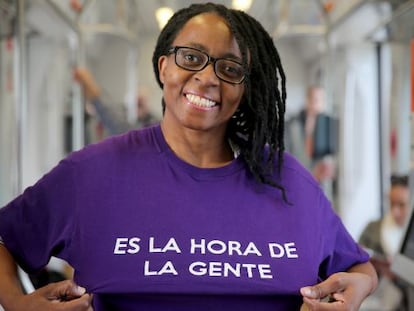‘Quinceañera’ parties: an inside peek at an emerging trend in Spain
Latino communities are keeping tradition alive with lavish, professionally planned celebrations

The dress – a blue-and-mauve affair made with satin, tulle and costume jewelry – takes up the entire floor inside the tiny room. Reams of sheeny fabric are piled up between a bed filled with teddy bears and a table full of makeup. Alejandra Zapata is at that delicate age when both mascara and soft toys are an important part of her life. Today is her quinceañera party, a ritual symbolizing the passage from girlhood to womanhood that is widely observed across Latin America – from Mexico to Argentina, and Bolivia to Ecuador.
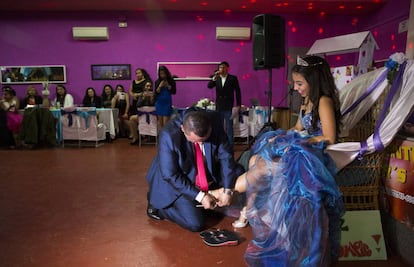
But Aleja happens to live in Getafe, a town on Madrid’s industrial belt. Her parents arrived there from Colombia 18 years ago, so Aleja was born in Spain – even though her strong Colombian accent seems to suggest that she has just stepped off a plane.
And celebrating her 15th birthday just the way she would in a land that she has only been to on visits is nothing short of “a dream come true,” she says, adjusting her tiara.
Most of my customers are working class, so they have to save to give their girl the best party they can afford
Rose Ballesta, owner Eventos Principesa
A white limo is waiting at the door. It is time to go. Around 100 guests are waiting inside a warehouse in a nearby industrial park. The walls of the event hall have been painted fuchsia.
For many Spaniards, their first encounter with these Latino parties was last November, when a quinceañera party in San Luis Potosí (Mexico) attracted around 30,000 guests after the birthday girl’s father issued a blanket invitation that went viral on social media.
Yet every weekend, in suburbs across Spain, Latino immigrants celebrate their own quinceañera parties. Little is known about them outside these communities themselves, but their popularity is such that there are now companies specializing in organizing quinceañera parties with all the pomp of a wedding, hundreds of guests and budgets running into the thousands of euros.
The stretch limo pulls up in front of the warehouse, looking incongruous among the surrounding scrapyards. The streets are poorly paved and there is no lighting. We cross a nondescript corrugated metal door, pass two girls looking decidedly cold as they smoke a cigarette in their gala dresses, and go through another metal door.
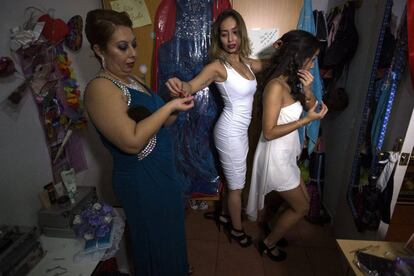
And suddenly, a parallel world of light and color appears, sugary and soulless at the same time. Items on display include a throne wrapped in tulle, plastic flowers, two cakes (a giant fake one and a tasty real one), balloons, a scale model of a castle and bowls of popcorn.
Over in a corner, la señora Luz, who hails from Ecuador, hovers over a baby pram filled with Latin sweets. A DJ is playing bachata, cumbia and reggaeton. Out of the 100 or so guests – half of them adults, half of them teenagers – only half a dozen or so are Spanish. One of them is Luis, the birthday girl’s uncle.
“It’s all a bit excessive, but we have to respect it,” he notes.
There are important moments throughout the event: the waltz, the speeches. The mother paints her daughter’s lips red, the father slips silvery high-heeled sandals on her feet.
It’s normal for Spaniards not to participate in these parties, because for immigrants it’s a way to preserve and protect their identity
Luisa Sánchez-Rivas, sociolonguist
But ultimately, what is being held here is not so much an archaic initiation rite (both parents and teens agree that at 15, a girl is still a girl) as a celebration of the community.
“Every ritual of passage has a threshold,” explains Luisa Sánchez Rivas, a sociolinguist who specializes in the concept of liminality – the intermediate or transitional phase of a ritual, somewhere between the original condition and the final one.
Liminality, which comes from the Latin term limen for threshold, has become a trendy word to describe the transitioning identity of hybrid cultures born out of immigration.
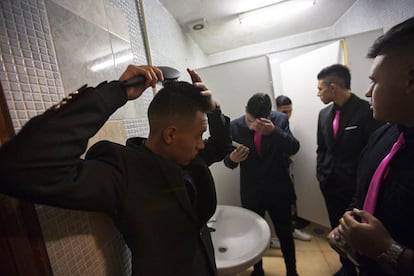
And the flowered arch that Aleja walks through symbolizes not just the passage to womanhood, but the abstract threshold of cultural identity for second-generation immigrants in Spain.
“They are Spanish and they are not,” says Sánchez Rivas. “In terms of identity, they live in an intermediate place between their parents’ country of origin and the destination country where they grew up.”
Every weekend, in the darkness of an industrial zone, the traditions of Medellín, La Paz and San Luis Potosí are coming to life for girls who were born in the deeply Madrileño areas of Getafe, Usera or Vallecas, but who act and feel part of both worlds. And it’s all happening a 15-minute trip from downtown Madrid.
Aleja’s friends are officiating as maids and gentlemen of honor. The girls are wearing short white dresses, the boys are all in dark suits and pink ties. Their hairdos have been carefully tended to. They are all the children of immigrants, and many, like Aleja, preserve the accent of the country where they were never born.
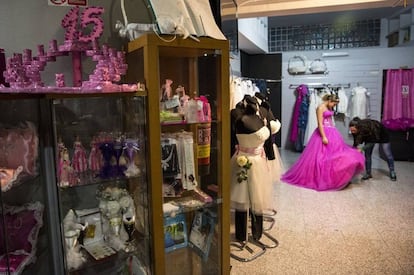
Aleja’s older sister Juliana, who is 25, arrived in Spain as a teenager, yet has a much less pronounced Colombian accent. “I quickly started hanging out with Spaniards,” she explains. “But they [her sister and friends] have a very closed circle. They even dress in the Colombian style!”
“Before this, the priority used to be integration, but among US Chicanos, North Africans in France and other hybrid cultures, the trend is now toward integration into the job market and the school system, but a closed social and family circle,” says the sociolinguist.
“It’s normal for Spaniards not to participate in these parties, because for immigrants it’s a way to preserve and protect their identity,” she adds.
Three a week
In an alley in the working-class district of Vallecas, the owner of Eventos Principesa, an event-organization firm, agrees.
“The quinceañera party is more important to the parents than to the girls,” says Rose Ballesta. “Some girls want nothing to do with it, but the parents don’t want them to forget where they came from.”
Ballesta, 28, who is herself from the Spanish island of Mallorca, organizes two to three parties a week. She opened the store four years ago, and business has been brisk ever since. In fact, she has moved to bigger business premises, and is now working on incorporating an event hall into her services.
Her best-selling product, the “all-included pack,” starts at €1,850. It includes the dress, limo, decoration, makeup and hairdressing, and involves the work of a dozen people, from seamstresses to DJs, to photographers and even choreographers.
As for nationalities, the party planner has seen them all: Dominican, Bolivian, Peruvian, Ecuadorean. Once there was even a Spanish girl
And then there are the extras: mariachis, dresses for the maids of honor, catering service... A few months ago, Ballesta recalls, one girl arrived at her own party in a helicopter.
“Families spend between €3,000 and €4,000 on average,” reveals Ballesta, who describes herself as a “low-cost wedding planner.”
“Most of my customers are working class, so they have to save to give their girl the best party they can afford,” she says.
As for nationalities, she has seen them all: Dominican, Bolivian, Peruvian, Ecuadorean. Once there was even a Spanish girl.
“Some of them go for that whole princess thing. But it’s not the same, they don’t take it as seriously.”
Hours before the party itself, the Zapata family attended a Mass officiated by a young Colombian priest. Bernardo and Dadiana, Aleja’s parents, showed off their pride in their child.
“She is a very good girl, very quiet, honest and studious, not at all vulgar; Spanish girls are more liberal, they smoke more, they go out...,” they said.
After the homily, which versed on the dangers of alcohol, drugs, boyfriends and the secularization of life in Spain, Aleja posed for the photographer in one of her three dresses of the evening. Elderly Spanish folks started showing up for the regular Mass, and they shot curious looks at this happy-looking teenager standing before the altar in her high heels. They seemed confused: she looked too old for the First Communion, but too young to be a bride.
English version by Susana Urra.
Tu suscripción se está usando en otro dispositivo
¿Quieres añadir otro usuario a tu suscripción?
Si continúas leyendo en este dispositivo, no se podrá leer en el otro.
FlechaTu suscripción se está usando en otro dispositivo y solo puedes acceder a EL PAÍS desde un dispositivo a la vez.
Si quieres compartir tu cuenta, cambia tu suscripción a la modalidad Premium, así podrás añadir otro usuario. Cada uno accederá con su propia cuenta de email, lo que os permitirá personalizar vuestra experiencia en EL PAÍS.
¿Tienes una suscripción de empresa? Accede aquí para contratar más cuentas.
En el caso de no saber quién está usando tu cuenta, te recomendamos cambiar tu contraseña aquí.
Si decides continuar compartiendo tu cuenta, este mensaje se mostrará en tu dispositivo y en el de la otra persona que está usando tu cuenta de forma indefinida, afectando a tu experiencia de lectura. Puedes consultar aquí los términos y condiciones de la suscripción digital.
More information
Archived In
Últimas noticias
Maduro pleads not guilty before the federal court in New York: ‘I am still the president of Venezuela’
A new test can detect Alzheimer’s from a finger prick
UN team enters Sudanese city of El Fasher after paramilitary massacre: ‘It’s like a ghost town’
A recipe for resistance: Indigenous peoples politicize their struggles from the kitchen
Most viewed
- Gilles Lipovetsky: ‘If you want to live better and fall in love, take Prozac, don’t look to philosophy’
- Alain Aspect, Nobel laureate in physics: ‘Einstein was so smart that he would have had to recognize quantum entanglement’
- Maduro’s downfall puts China’s relationship with Venezuela to the test
- Why oil has been at the center of Venezuela-US conflicts for decades
- Alvin Hellerstein, a 92-year-old judge appointed by Bill Clinton, to preside over Maduro’s trial in New York

